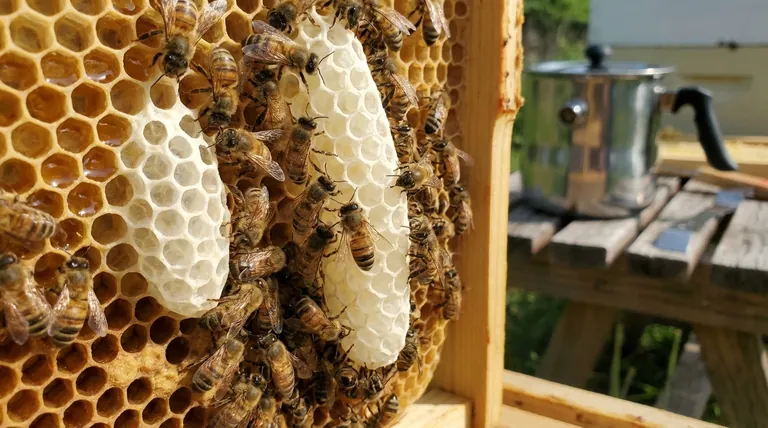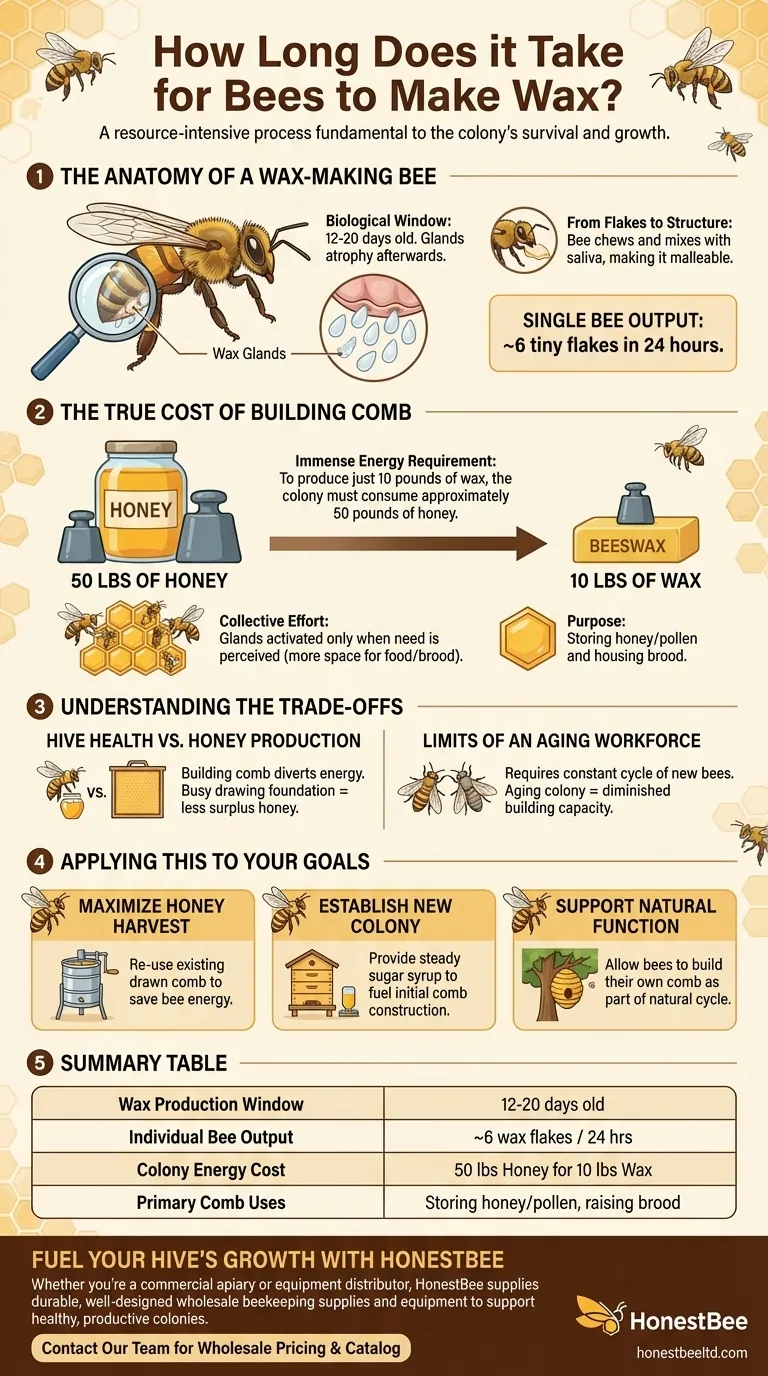On a microscopic level, a single worker bee can produce about six tiny flakes of wax in a 24-hour period. This production, however, is part of a much larger and more resource-intensive process that is fundamental to the entire colony's survival and growth.
The ability of a honey bee to produce wax is confined to a specific, short period in its life and requires an immense amount of energy from the entire colony, making beeswax one of the hive's most valuable resources.

The Anatomy of a Wax-Making Bee
Wax production is not a lifelong capability for a honey bee. It is a specialized role performed during a distinct phase of a worker bee's development.
The Biological Window for Production
A worker bee’s wax glands become fully active when she is between 12 and 20 days old. Before this period, she serves as a cleaner or nurse bee; afterward, her glands atrophy as she transitions into a forager.
The Wax Glands
Bees produce wax from specialized glands located on the underside of their abdomen. The wax is secreted as small, clear flakes, which are initially brittle.
From Flakes to Structure
After secreting the flakes, the bee manipulates them with her legs and mandibles. She chews the wax, mixing it with saliva to make it malleable and ready for construction.
The True Cost of Building Comb
The creation of a single beeswax comb is a monumental task that requires the coordinated effort of thousands of bees and a significant expenditure of the hive's energy reserves.
The Energy Requirement
Building comb is an incredibly resource-intensive process. The colony must consume approximately fifty pounds of honey to produce just ten pounds of beeswax.
A Collective, Needs-Based Effort
Worker bees do not produce wax constantly. They only activate their glands when they perceive a need within the hive, such as requiring more space for storing food or raising brood.
The Purpose of the Comb
The bees meticulously shape the wax into the iconic hexagonal cells of a honeycomb. This structure is used for two critical purposes: storing honey and pollen, and housing the developing larvae, pupae, and queen's eggs.
Understanding the Trade-offs
The decision to produce wax has significant implications for the colony's overall resource management and focus.
Hive Health vs. Honey Production
When bees are focused on building new comb, they divert a massive amount of energy (in the form of honey) away from storage. For a beekeeper, this means a colony busy drawing out new foundation will produce significantly less surplus honey.
The Limits of an Aging Workforce
A healthy hive requires a constant cycle of new bees to maintain its building capacity. If a colony's population ages and has fewer young "builder" bees, its ability to repair comb or expand is severely diminished.
Applying This to Your Goals
Understanding the effort behind wax production allows you to better support your bees, whether you are a beekeeper or simply a conservationist.
- If your primary focus is maximizing honey harvest: Re-use existing drawn comb whenever possible, as this saves your bees an enormous amount of energy.
- If your primary focus is establishing a new colony: Provide a steady source of sugar syrup to fuel the immense energy needs of initial comb construction.
- If your primary focus is supporting natural hive function: Allow bees to build their own comb, recognizing that this is a vital and resource-intensive part of their natural cycle.
Appreciating the true cost of beeswax is fundamental to understanding the remarkable efficiency and industriousness of a healthy honey bee colony.
Summary Table:
| Key Aspect | Details |
|---|---|
| Wax Production Window | Worker bees produce wax between 12-20 days old. |
| Individual Bee Output | A single bee produces ~6 wax flakes in 24 hours. |
| Colony Energy Cost | ~50 lbs of honey is consumed to produce 10 lbs of wax. |
| Primary Comb Uses | Storing honey/pollen and raising brood (larvae). |
Fuel Your Hive's Growth with the Right Equipment
Understanding the immense energy your bees invest in wax production is the first step to maximizing their efficiency. Whether you're a commercial apiary focused on honey yield or a beekeeping equipment distributor supplying the industry, having durable, well-designed equipment is crucial.
HONESTBEE supplies the wholesale beekeeping supplies and equipment that support healthy, productive colonies. From foundations that guide comb construction to feeders that provide essential energy, our products are built for the demands of commercial-scale operations.
Let's discuss how we can support your business goals. Contact our team today to learn more about our product catalog and wholesale pricing.
Visual Guide

Related Products
- Beeswax Melter for Candle Making Honey Bee Wax Melter
- Steam Beeswax Melter Wax Warmer for Wax Processing
- Professional Stainless Steel Wax Melter for Beekeeping and Crafts
- Electric Flatting and Embossing Machine with Tray for Beekeeping
- Electric Beeswax Flat Sheet Machine with Operating Tray for Wax Processing
People Also Ask
- What are the main types of wax melters? Choose the Right Heating Method for Your Needs
- What are the primary products of honey bee farming besides honey? Discover the Hive's Hidden Treasures
- How does a steam wax melter work? A Fast, Efficient Method for High-Quality Wax
- What is the best way to melt beeswax for candles? The Safest Method for Professional Results
- How do water jacket melters function? Achieve Gentle, Scorch-Free Melting for Sensitive Materials



















